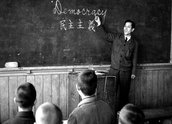

Searchlight on Japan (c.1948)
Synopsis
This documentary surveys Japan under Allied occupation at the end of the Second World War. It includes the impact of democratisation, re-education and the ‘rehabilitation’ of the Japanese people and its institutions of power.
Curator’s notes
Made by Ken G Hall as part of Cinesound’s schedule of propaganda films in support of the Allied war effort, Searchlight on Japan focuses largely on how the post Second World War occupation and 'rehabilitation’ affects the civilian population of Japan. The narrator says the film is 'for the man on the street’ who knows little about postwar Japan. This would have been the majority of any cinema audience in 1948 Australia. Postwar Japan was occupied by the Allied forces from 1945 to 1952 and, during that time, the structures of a modern Western democracy were imposed on the country. The introduction to Searchlight on Japan states that the film presents 'essentially an Australian point of view’ on Japan, making it clear from the outset that the film is positioned firmly within a democratic and Western ideological framework.
In propaganda films, the images, music and text are used to argue an ideological position. Here, it is the narration that colours otherwise neutral images. The position of women in traditional Japanese society, for example, is presented as one of inferiority but the accompanying images (of happy children playing in a classroom, or women standing quietly in the streets) do not support these statements (see clip one and clip two). The narration suggests that the ‘Matsuno-sans’ of Japan (a character type shown in clip two and used to make generalisations about the Japanese) may appear to accept their rehabilitation, but still see the Allies as 'white barbarians’. This highly suggestive language about what goes on in the 'hearts and minds’ of the Japanese is tempered slightly by acknowledging that they have their problems, like all those who have felt the 'hot breath of war’.
Australian audiences watching the film at the time would have had strong feelings towards Japan but little direct contact with its people. Those feelings were most likely associated with the taking of Australian POWs during the Second World War as well as through accounts from front-line battles against the Japanese at places like Kokoda. Cinesound’s Academy Award-winning newsreel special Kokoda Front Line! (1942) focused on the courage and determination of the Australian digger, but also encouraged fear of the invisible enemy, the Japanese. After the war, this distrust of the former enemy would have left its traces in the Western consciousness. In this context, Searchlight on Japan is a reassuring propaganda piece which demonstrates the efforts the Allies are making to bring social, economic, and political changes to the country and that the rehabilitation of its people is slowly, but surely, taking place.
- Overview
- Curator’s notes
- Video 2 clips

- Principal credits
- Find a copy
- Make a comment
- Add your review



